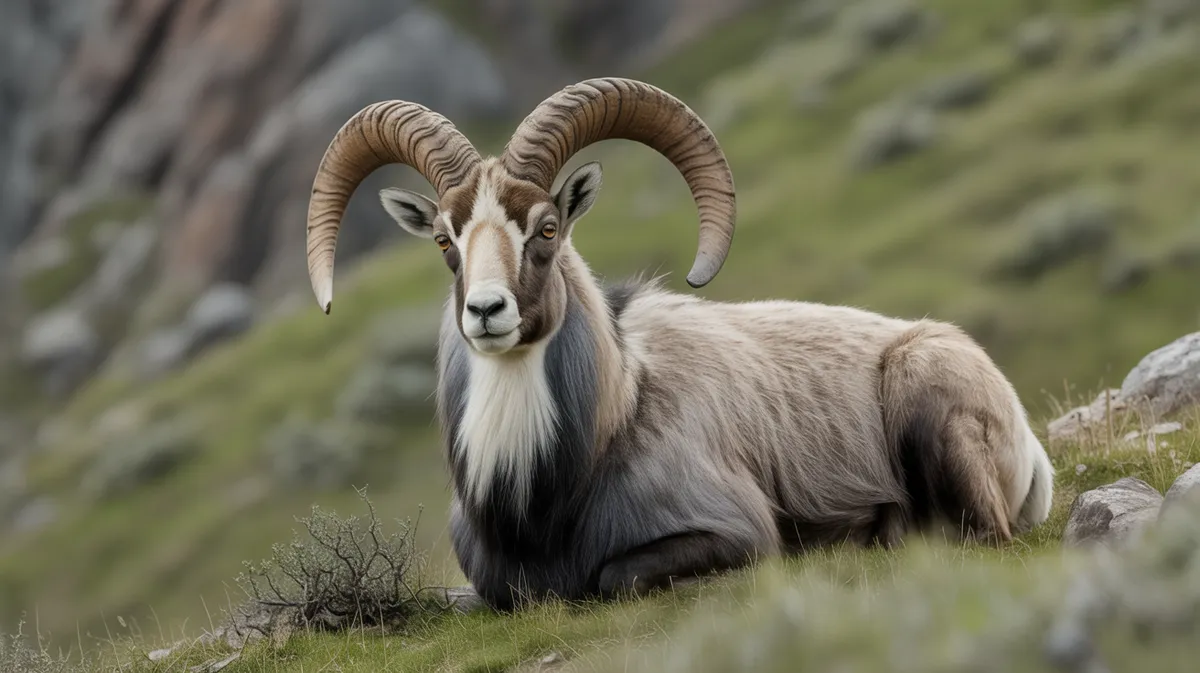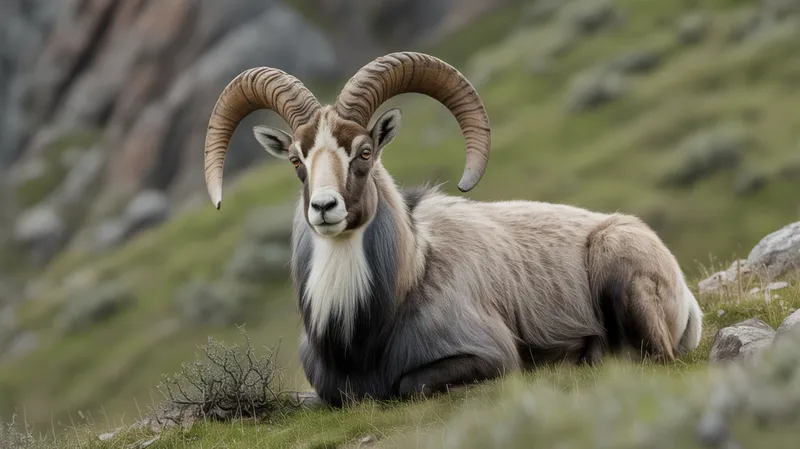
Bharal (Blue Sheep)
Pseudois nayaur

Meet the Bharal (Blue Sheep)
The Bharal, commonly known as the Blue Sheep, is a robust mountain ungulate native to the high Himalayas, including regions of India, Nepal, Bhutan, Tibet, and Pakistan. Noted for their bluish-gray coats, which provide excellent camouflage among rocky slopes, Bharals are agile climbers capable of navigating steep, rugged terrain with ease. Both males and females have horns, though the rams’ are larger and curve backward in a distinctive arc. They live in herds that can number from a few individuals to several dozen, relying on keen senses and agility to evade predators such as snow leopards and wolves.
Classification
Mammal
Habitat
Mountain grasslands and rocky slopes
Diet
Herbivore
Lifespan
10-15 years
Conservation
Least Concern
Weight
35-75 kg
📖Fascinating Facts
Agile Climbers
Bharals are masters of steep, rocky terrain and can effortlessly scale cliffs to escape predators or search for food.
Camouflaged Coats
Their thick, blue-gray fur blends perfectly with their rocky mountain habitat, making them difficult to spot from a distance.
Impressive Horns
Male bharals grow large, curved horns that can reach up to 80 cm in length and are used in dramatic head-butting contests during the rut.
📋Detailed Description
The Bharal (Pseudois nayaur), or Blue Sheep, is a medium-sized caprid with a robust, muscular build, standing 75–90 cm at the shoulder and weighing between 35–75 kg, with males generally larger than females. Its dense, woolly coat is slate-blue to grayish, providing exceptional camouflage against the rocky Himalayan landscapes it inhabits. Both sexes bear horns: males' horns are thick, sweeping backward and outward up to 80 cm, while females' are shorter and more slender. The Bharal's head is short and broad, with a straight profile and prominent, forward-facing eyes that afford a wide field of vision—an adaptation for predator detection. Limbs are strong and relatively short, with specialized hooves featuring a hard outer rim and a soft, grippy core, enabling secure footing on steep, unstable terrain. Socially, Bharal are gregarious, forming herds of 5–50 individuals, though aggregations of over 200 have been recorded in winter. These herds are typically segregated by sex outside the breeding season, with bachelor groups and female-offspring groups. Bharal are crepuscular, being most active during early morning and late afternoon, and spend much of their time grazing or ruminating. Their diet shifts seasonally, with a preference for grasses, herbs, and sedges in summer, and woody plants, lichens, and mosses in winter. Bharal play a pivotal ecological role as primary prey for the endangered snow leopard (Panthera uncia) and as grazers influencing alpine vegetation dynamics.
💡 Did you know?
Bharals play a critical ecological role as the primary prey of the endangered snow leopard, helping maintain balance in the Himalayan ecosystem.
🔬Research & Sources
🎭Behavior & Social Structure
Bharal exhibit a high degree of vigilance, often positioning themselves on elevated outcrops to scan for predators. Their primary anti-predator strategy is flight rather than confrontation, utilizing their agility to escape along precipitous cliffs. Feeding occurs in loose groups, with individuals spreading out to minimize competition, and they may travel considerable distances between feeding and resting sites. Social hierarchies are established among males, especially during the rut, through displays and occasional horn clashes. Outside the breeding season, social interactions are generally peaceful, with frequent allogrooming and play among juveniles. Daily routines include alternating periods of grazing, ruminating, and resting, with midday hours often spent sheltering from intense sun or inclement weather. Bharal are known to migrate vertically, descending to lower elevations in winter to access snow-free forage, and returning to higher pastures in summer.
👶Reproduction & Life Cycle
The Bharal breeding season (rut) occurs from late November to January. During this period, males compete for access to estrous females through displays, vocalizations, and sometimes direct combat. Dominant males may control small harems, but mating is generally promiscuous. Gestation lasts approximately 160–170 days, with most births occurring between late May and early July. Females typically give birth to a single lamb, though twins are rare. Newborns are precocial, able to stand and follow their mothers within hours. Mothers isolate themselves briefly during parturition, rejoining the herd soon after. Parental care is provided exclusively by the female, with lambs weaned at 4–6 months. Sexual maturity is reached at 2–3 years for females and 3–4 years for males.
🛡️Adaptations & Survival
Bharal are highly specialized for life in rugged, high-altitude environments (2,500–5,500 meters). Their compact bodies minimize heat loss, while dense underfur insulates against cold. The unique structure of their hooves—hard-edged with a rubbery core—provides exceptional grip on rocky surfaces. Their coloration blends seamlessly with the granite and scree slopes, offering camouflage from predators. Physiologically, Bharal have a high red blood cell count and efficient oxygen transport mechanisms to cope with hypoxic conditions. Behaviorally, their crepuscular activity avoids midday heat and maximizes foraging efficiency. Seasonal vertical migrations allow them to exploit different vegetation zones and avoid deep snow.
📚Research Sources
🎨Cultural Significance
Bharal hold significant cultural value in Himalayan societies. In Tibetan Buddhism, they are considered sacred and are often associated with mountain deities. Their horns are used in traditional medicine and as ritual objects in some communities. Bharal are also featured in local folklore and are a symbol of the high-altitude wilderness. Their ecological role as prey for the snow leopard has led to their inclusion in conservation programs aimed at preserving both species and their shared habitats.
🔬Recent Research & Discoveries
Recent genetic studies have clarified the phylogenetic relationships of Bharal within the Caprinae subfamily, supporting their close affinity to goats (genus Capra) rather than true sheep (genus Ovis). Ongoing telemetry and camera-trap research are providing insights into their movement ecology, habitat use, and responses to human disturbance. Studies on Bharal diet and foraging behavior are informing rangeland management and conservation strategies, particularly in areas of livestock-wildlife conflict. There is increasing interest in the role of Bharal as ecosystem engineers, influencing plant community composition through selective grazing.
🎥Wildlife Videos

Blue Sheep/Mammals of Ladakh/Zanskar/#ladakhi #new #viralvideo #wildlife #documentary
HIMALAYAN LADAKH

Blue sheep defy the laws of physics#animals #funny #ibex
Giovani Gonzalez

Bharal - Himalayan Blue Sheep
Bharal have excellent camouflage in their rocky Himalayan home and will stand motionless when approached, making them ...
Highland Wildlife Park

Namaste Himalaya - A Blue Sheep Expedition
A high altitude hunting adventure of true grit and determination. The Himalayas of Nepal turned out to be CANIS founder Ryan ...
CANIS

All 8 Wild Sheep Species (Including 2 Controversial)
Explore all 8 wild sheep species including all 6 members in the Ovis genus and two other closely related animals. Chapters 0:00 ...
Textbook Travel

Fatal Pursuit: Snow Leopard Sends Blue Sheep Down the Mountain
snowleopard #wildanimals #mountains Snow Leopard's Killer Chase: Blue Sheep's Dramatic Cliff Dive ...
Wild Animals Uncensored
🌍Habitat Information
The Bharal (Blue Sheep) typically inhabits Mountain grasslands and rocky slopes environments. Bharal (Blue Sheep)s have adapted to their environments with specialized features and behaviors.
Primary Habitat:
Mountain grasslands and rocky slopes
More detailed habitat information will be available soon.
🛡️Conservation Status
The Bharal (Blue Sheep) is currently classified as Least Concern. Conservation efforts are crucial for preserving this species for future generations.
Common Threats:
- 🏠Habitat loss and fragmentation
- 🌡️Climate change impacts
- 🎯Hunting and poaching
- 🏭Human-wildlife conflict
⚠️Threats & Conservation Challenges
While currently listed as Least Concern, Bharal populations face localized threats from habitat loss due to livestock overgrazing, competition with domestic sheep and goats, and infrastructure development (roads, tourism). Poaching for meat and horns persists in some regions, although not at levels causing widespread decline. Disease transmission from livestock is an emerging concern, as is climate change, which may alter alpine vegetation and snow patterns, affecting forage availability. Population trends are generally stable, but some subpopulations are declining due to intensified human activity and fragmentation.
🔬Scientific Classification
Scientific Name
Pseudois nayaur
Classification Hierarchy
🔍 About Taxonomic Classification
Taxonomic classification is a hierarchical system used by scientists to classify and organize living organisms based on shared characteristics and evolutionary relationships.
The system moves from broad categories (Kingdom) to increasingly specific ones, with each animal's scientific name typically consisting of its Genus and species.
📝Community Notes
Share your observations and insights about the Bharal (Blue Sheep) with our community of wildlife enthusiasts.
Join Our Community
Sign in to share your observations and connect with fellow wildlife enthusiasts.
Sign In to ContributeNo community notes yet
Be the first to share your observations about the Bharal (Blue Sheep)!
Explore Bharal (Blue Sheep)
Select a tab above to learn more about this amazing animal.
📸Photo Gallery
No photos available for this animal yet.
🌟Discover More Wildlife
Continue your journey of discovery with more fascinating animals from our database
